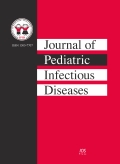Authors: Singhi, Sunit | Khilnani, Praveen | Lodha, Rakesh | Santhanam, Indumathi | Jayashree, M. | Ranjit, Suchitra | Ramachandran, Bala | Ali, Uma | Sachdev, Anil | Chugh, Krishan | Udani, Soonu | Uttam, Rajiv | Deopujari, Satish | Kissoon, Niranjan
Article Type:
Research Article
Abstract:
WHO 2005 data points to sepsis in form of pneumonia, diarrhea, and neonatal sepsis as major killers of children in the resource limited countries of Asia and Africa, However, currently there are no specific published guidelines for treatment of severe sepsis in resource limited circumstances. An expert panel drawn from all over India, met to discuss and draw guidelines for management of pediatric septic shock that are applicable to resource limited countries. The group evaluated strength
…of published data and expert opinion for clinical practice and feasibility of delivery of care at various levels of resource constraints, keeping in view unique patient population and limited availability of equipment and resources. Issues for discussion included simplified definitions and reliable clinical indicators of septic shock, fluid resuscitation, graded inotropic and vasopressor support, corticosteroid therapy, timing and indication for endotracheal intubation and use of positive end expiratory pressure/mechanical ventilation, initial empirical antibiotic therapy, correction of hypoglycemia and glycemic control, role of immunoglobulin, and blood and blood products. Evidence has been graded and levels of evidence indicated wherever applicable. The expert group recognized and listed potential barrier to implementation of existing American College of Critical Care Medicine guidelines for treatment of septic shock in resource limited countries, adopted simplified definitions of septic shock, tachycardia, tachypnea and hypotension, and developed step-wise algorithmic approach for treating septic shock. Evidence based treatment recommendations include early oxygen therapy, fluid resuscitation based on blood pressure, use of dopamine in fluid refractory shock, early use of antibiotics, early intubation and assisted ventilation, correction of hypoglycemia and emphasis on use of physical examination for achieving therapeutic endpoints. These interventions have brought the mortality down and can be easily applied even at primary and/or secondary level health facilities. Interventions recommended after above steps were based on consensus rather than evidence. These include stress dose steroid therapy, use of vasopressors and inodilators, and central venous pressure and echocardiography to guide fluid and vasoactive drug infusion, which require transfer to a pediatric intensive care unit. Strict glycemic control is not recommended. Evidence on benefit of several other interventions viz. use of vasopressin as vasopressor, use of intravenous immunoglobulins, renal replacement therapy, use of plasmapheresis etc. is emerging. The expert group observed that further research evaluating individual components of guidelines and relative benefit of each of these interventions in resource limited setting is needed, as also the benefit of adherence with standardized protocol. Pediatric sepsis guidelines suitable for resource limited settings are presented for resource limited settings. Several unresolved issues were identified for further research.
Show more
Keywords: Children, emergency care, septic shock, fluid resuscitation, vasoactive drugs
DOI: 10.3233/JPI-2009-0162
Citation: Journal of Pediatric Infectious Diseases,
vol. 4, no. 2, pp. 173-192, 2009
Price: EUR 27.50





